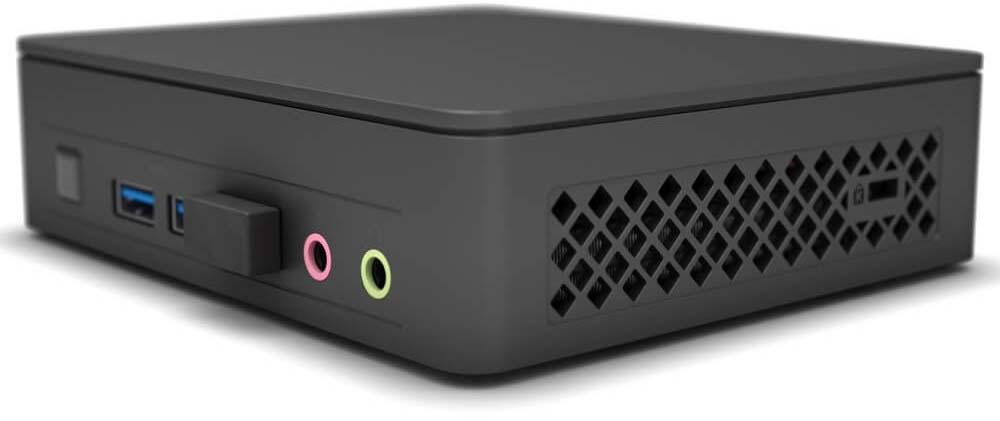Intel NUC
Intel has been selling really small, stable and affordable computers under the name "NUC" for quite some time now. They have always been sold as "barebones", meaning that you still need to buy and install a few things yourself: memory and (optionally) a hard drive (or better: an SSD). Newer models are also available fully assembled and with a version of Windows on them. But these obviously cost a little more.

Intel offers a whole range of NUCs, from ones with a basic Atom processor up to ones with a Core i7. Most of our customers like the good price/performance ratio of the Pentium-based processors.
Platform Of Your Choice
Since the Intel NUC is just a generic computer, you can run any operating system on it that you like. Most popular choices are:
- NixOS Kiosk: this is the simplest setup.
- Windows: this is always a very solid choice, especially since the most and best hardware drivers are available for Windows, so you can expect good performance. The main drawback is that it is a bit more expensive since you'll need to buy a Windows license and an SSD (or hard drive).
- Linux: this is a great free option, especially if you're familiar with Linux. The main drawback is that you need the SSD (or hard drive). And it takes a little more work to set up than when you're using NixOS Kiosk.
What Memory And Hard Drive?
If you choose the barebone variant, then at least you need to install some memory yourself. Optionally you can install a hard drive or SSD. Starting with the latter: essentially anything will do. You don't need a lot of storage, so a drive with a capacity of as little as 30GB will do just fine in all scenarios. Since SSDs of that capacity aren't that expensive anymore and are more reliable than harddrives, we actually recommend choosing an SSD over a hard drive.
For many NUC models, Intel sells a tall (H) model and a slim (K) model. The slim model only fits an SSD with a M.2 connector. The tall model also fits a hard drive or SSD with a regular SATA connector, besides an SSD with a M.2 connector.
As for memory; Intel always tests their computers with different types of memory. When you've decided on a certain NUC model, always be sure to pick the memory tested by Intel. You will find a list of compatible "system memory" (like this one) for each model on their website. We have found the Kingston ones to be most readily available at a good price. For normal use we recommend 4GB of memory, for use with more/mainly video we recommend 8GB.
Pros
- Good performance for the price.
- Robust machine from a respected brand.
- Small enough to mount behind almost any screen (smaller than a Chromebox, for example).
- Choose any operating system you like.
Cons
- In the barebone variant, you still need to install some extra hardware yourself.
Conclusion
If you're prepared to do some extra work to gain some flexibility, then the NUC is a better choice than -for example- the Chromebox. The performance of the newer Celerons and Pentium processors is already good, therefore the NUC is highly recommended.
To iron out the last animation jitters, choose a model with a Core i3, i5 or i7 processor.